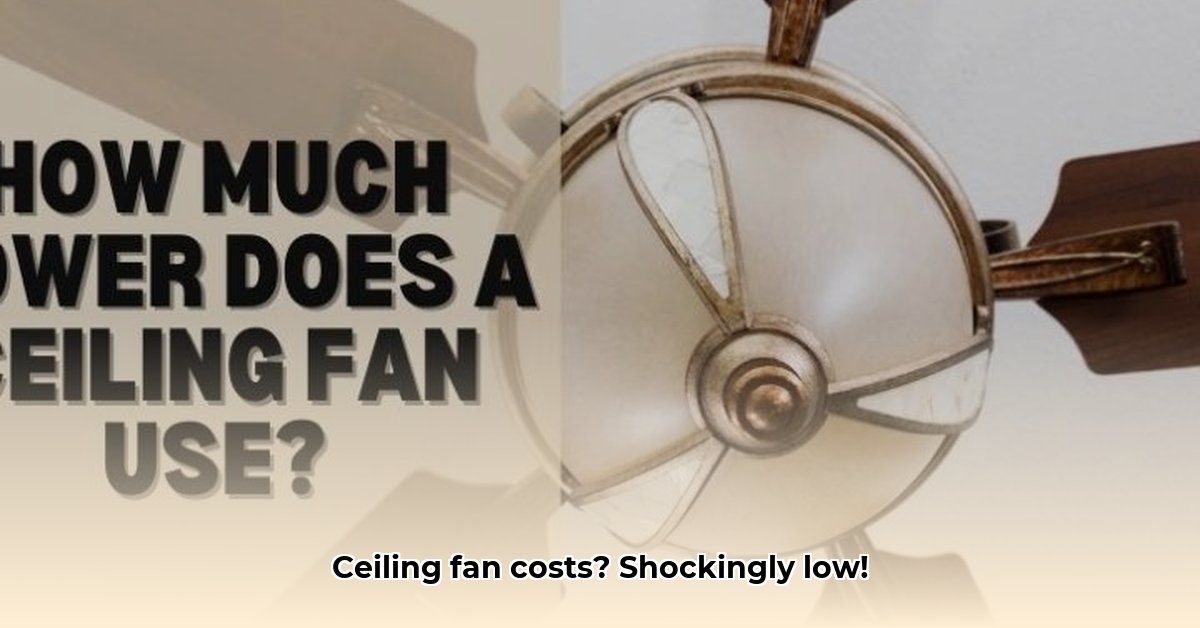Ceiling fans are a cost-effective way to stay cool, but how much electricity do they really use? Let’s break down the costs, compare them to AC, and explore how to maximize their efficiency.
Watts, Kilowatts, and Cents: Understanding the Basics
Before we dive into costs, let’s clarify some terms. “Wattage” (W) measures how much electricity an appliance uses at any given moment. A higher wattage means it uses more power. Most ceiling fans use between 30 and 100 watts—significantly less than most other appliances. Your electric company charges you by the “kilowatt-hour” (kWh), which is 1,000 watts used over an hour.
Calculating the Cost: Pocket Change for a Breeze
Figuring out your fan’s running cost is simple:
Cost = (Wattage × Hours Used × Electricity Price per kWh) / 1000
For example, a 75-watt fan running for 8 hours at an electricity rate of $0.16/kWh costs about $0.10 per night. That’s less than a dime!
| Wattage (W) | Cost per Hour ($0.16/kWh) | Cost per Night (8 hours) |
|---|---|---|
| 30 | $0.005 | $0.04 |
| 50 | $0.008 | $0.06 |
| 75 | $0.012 | $0.10 |
| 100 | $0.016 | $0.13 |
Note: These costs are estimates. Your actual cost will depend on your fan’s wattage, usage time, and local electricity rates.
Ceiling Fan vs. AC: A Cost-Saving Showdown
How do ceiling fans stack up against air conditioners? A central AC unit can use thousands of watts, costing dollars per hour—much more than a ceiling fan’s pennies. While a fan doesn’t lower room temperature, its wind-chill effect makes you feel cooler. This allows you to raise your AC’s thermostat, significantly reducing its energy consumption. Using both together is the ultimate cost-saving strategy.
| Appliance | Wattage (approx.) | Cost per Hour (at $0.16/kWh) |
|---|---|---|
| Ceiling Fan | 60W | $0.01 |
| Window AC Unit | 1000W | $0.16 |
| Central AC Unit | 3500W | $0.56 |
Maximizing Efficiency: Tips and Tricks
- Optimize Blade Direction: In summer, blades should rotate counter-clockwise to push cool air down. In winter, reverse the direction to circulate warm air.
- Strategic Speed Control: Lower speeds use less energy. Find the balance between comfort and energy savings.
- Combine with AC: Use your fan with your AC to create a wind-chill effect and raise your thermostat a few degrees.
Beyond Ceiling Fans: Other Cooling Options
- Natural Ventilation: Open windows at night to let in cool air, then close them during the day.
- Window Coverings: Use curtains or blinds to block direct sunlight.
- Improved Insulation: Proper insulation reduces heat transfer, leading to lower energy bills year-round.
- Energy-Efficient Windows: Windows with low-E coatings minimize heat transfer.
- Smart Thermostats: Optimize your HVAC system based on your schedule and preferences.
Choosing the Right Fan: Size and Efficiency Matters
- Fan Size: A larger room generally requires a larger fan for adequate airflow. Consult sizing guides to find the right fit.
- Energy Star Label: Look for Energy Star certified fans, which are designed for optimal energy efficiency.
- DC Motors: Fans with DC motors are often more energy-efficient than those with traditional AC motors.
Ceiling Fan FAQs
How can I tell if my fan is balanced?
A wobbling fan suggests an imbalance, which can strain the motor and waste energy. Inexpensive balancing kits can correct this.
Are ceiling fans noisy?
Most modern fans are designed for quiet operation, but some are quieter than others. Look for models specifically marketed as “quiet” if noise is a concern.
What size ceiling fan do I need for my room?
The ideal size depends on your room’s dimensions. Larger rooms generally benefit from larger fans. Consult online resources or store associates for guidance.
While this information provides a comprehensive overview, ongoing research in energy efficiency may lead to evolving recommendations. It’s always wise to stay informed about the latest advancements.
- How to Stop Apps From Running in the Background to Boost Your - December 1, 2025
- How To Move Apps On Your Droid For Better Organization - November 30, 2025
- How to Move Apps on Android for Better Organization - November 29, 2025










